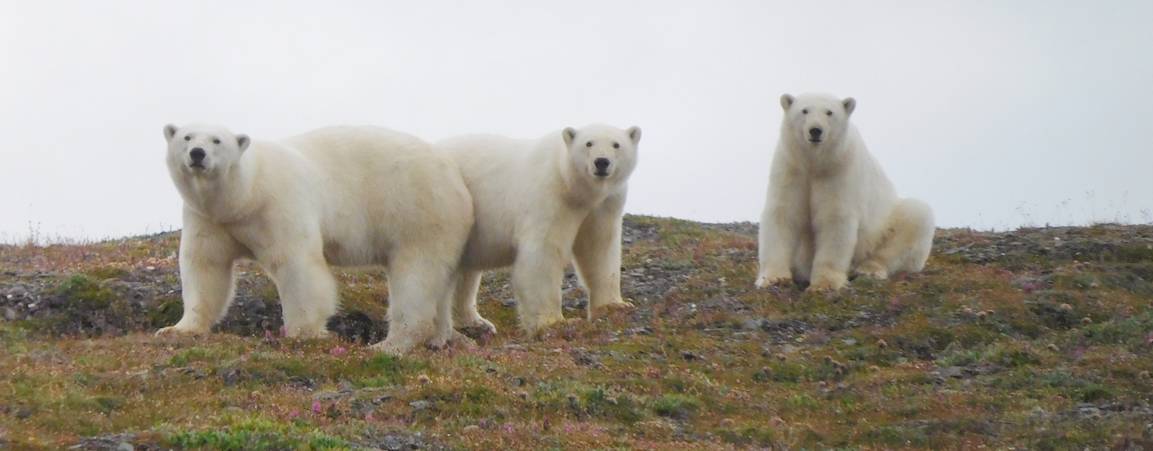Join us on our journey.
Become part of a community committed to protecting polar bears with our free newsletter.
Photo: Babiy Ulyana / Wrangel Island State Nature Reserve

The Chukchi Sea subpopulation of polar bears comprises approximately 3,000 bears that live on the sea ice in the Chukchi, Bering, and East Siberian seas. It straddles the boundary between Russia and the United States and contains the majority of the polar bears in the U.S.

A map highlighting the location of the Chukchi Sea polar bear subpopulation during the annual sea ice minimum. The other 19 subpopulations are outlined as well.
The Chukchi Sea polar bear subpopulation stretches approximately from Icy Cape, Alaska, to the western coast of Russia’s Wrangel Island. It is bordered by the Southern Beaufort Sea population to the east and by the Laptev Sea population to the west.
The region is characterized by a large continental shelf beneath shallow seas. Combined with ocean currents that bring nutrient-rich waters up through the Bering Strait, this makes the Chukchi Sea one of the most biologically productive ocean areas in the world, providing rich seal-hunting grounds for the region’s polar bears.
Polar bears in the Chukchi regularly travel between the U.S. and Russia; Dr. Eric Regehr of the University of Washington has described fitting an ear tag on a bear off western Alaska and then seeing that same bear 10 months later on Wrangel Island, more than 500 miles away.
The population is in the Divergent Sea Ice Ecoregion, in which ocean currents continually pull sea ice away from the coast. In summer, during the period when it is too warm for new ice to form, some bears in the Chukchi stay with the remaining ice as it travels north over the deeper waters of the Arctic Ocean basin, choosing to prioritize their favored habitat over the fact that the waters below are relatively nutrient-free. Other bears come ashore on Wrangel Island until ice begins to form again.

Photo: Babiy Ulyana / Wrangel Island State Nature Reserve
Measuring about 93 miles from east to west and 50 miles from north to south, Russia’s Wrangel Island is where most polar bears in the Chukchi Sea make maternity dens and give birth, and where the majority of bears of all ages and sexes spend the summer weeks when new sea ice is not being formed.
In late fall and winter, as many as 400 female polar bears may dig maternity dens in snow banks on the island, where they give birth to their cubs – normally two, but sometimes three and on at least one recent recorded occasion, four.
The 2,900-square-mile island, where woolly mammoths lived for 6,000 years after they had disappeared from the rest of the globe, is also home to wolverines, wolves, musk oxen, and, during late spring and summer, several hundred thousand walruses. It can at times host an extraordinary number of polar bears; Eric Regehr recalls informally counting roughly 800 during one month of study on the island. In his book Polar Bears: Living with the White Bear, Russian scientist Nikita Ovsyanikov, who spent several years studying polar bears on Wrangel and its smaller neighbor Herald Island, recalls counting as many as 37 bears in an area of about an acre.
Because of the high numbers of polar bears, walruses, and other wildlife, Russia has designated Wrangel Island as a zapovednik: a nature reserve under the strictest possible level of protection.
Polar bears that spend the summer on Wrangel may opportunistically prey on some of the wildlife of the island, such as lemmings and even walruses, but as with polar bears elsewhere in the Arctic, by far their primary prey is ringed and bearded seals that they catch on the sea ice.
Photo: Babiy Ulyana / Wrangel Island State Nature Reserve

The Chukchi Sea polar bear population straddles the boundary between Russia and the United States, and its management is coordinated by the U.S.-Russia Polar Bear Commission, which first met in 2009. Each country nominates two commissioners, one of whom is federally-appointed and one of whom is a representative of Indigenous organizations.
On the U.S. side, the official Indigenous partner is the Alaska Nannut Co-Management Council (ANCC), a tribally authorized organization consisting of the 15 tribes in Alaska that have traditionally harvested polar bears for subsistence. The ANCC is developing a co-management agreement with the U.S. Fish & Wildlife Service, which, if adopted, would grant a greater degree of self-determination to Alaska Natives to regulate their subsistence hunt.
At present, the subsistence harvest limit is 85 bears, of which no more than one-third may be female, split evenly between the two countries.

Photo: Babiy Ulyana / Wrangel Island State Nature Reserve
The first formal study of the Chukchi Sea subpopulation, led by Eric Regehr and published in 2018, estimated that it contained approximately 3,000 bears, and that the population had generally good reproductive rates and cub survival. Concurrent studies led by Karyn Rode of the U.S. Geological Survey concluded that they had similar levels of body fat as 25 years previously, suggesting that the population is in good health, numerically and nutritionally.
Subsequent studies by air and on Wrangel Island support the notion that the population is generally in solid shape, but there are warning signs on the horizon.
Because sea ice is melting earlier in summer and forming later in the fall in the Chukchi Sea, as elsewhere in the Arctic, polar bears in the region have access to their preferred habitat for a month less each year than historically was the case. That means less time to hunt seals and procure the energy they need. The fact that, so far, Chukchi bears appear to be weathering these changes is almost certainly a testament to the fact that the extremely high levels of productivity in the region are providing a buffer of sorts; however, if sea ice trends continue, it is inevitable that at some point, the impacts will begin to be felt.
As Regehr told Arctic Today following the publication of his study:
“When we find that for the past 10 years this population looked like it was doing well doesn’t necessarily imply that it will continue to do so in the future. There’s a lot we don’t know about how or when the effects of ice will show up in the subpopulations. But if ice continues to change as it has been, it definitely will [have an impact] at some point, whether that’s in two years or 20 years.”
Photo: Babiy Ulyana / Wrangel Island State Nature Reserve

Because Russia’s Wrangel Island is a critical resting place and denning location for the data-deficient Chukchi Sea polar bears, Polar Bears international helped support a collaborative study, now on pause due to the war in Ukraine, that focused on these bears. Led by Eric Regehr, the studies:
Used ground-based observations and non-invasive genetic samples (hair traps) to examine gene flow, diversity, and population dynamics to improve our understanding of how these bears fit into global polar bear diversity
Worked to improve our understanding of how Wrangel Island’s bears were handling the effects of increasing industrial activities and longer ice-free seasons due to climate warming
Project partners included the University of Washington, the Wrangel Island Nature Reserve, All-Russian Research Institute for Environment Protection and the U.S. Fish and Wildlife Service.

Become part of a community committed to protecting polar bears with our free newsletter.